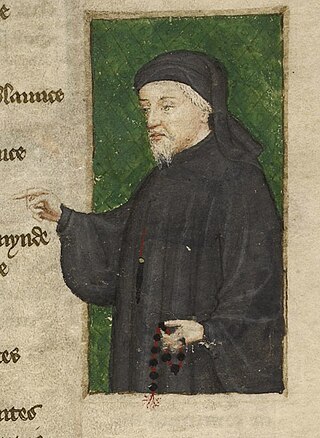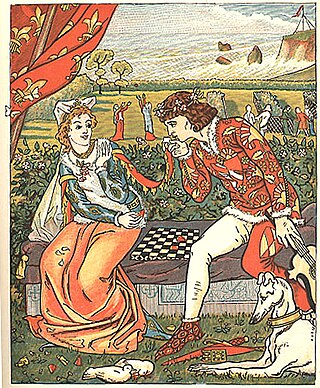Misogamy is an aversion to or hatred of marriage. The word dates from the mid-17th century and combines the Greek misos (hatred) with gamos (marriage). [1] Merriam-Webster date the first use of the word to around 1656. [2]
The idea of misogamy was important in the Christian church during the medieval period as a prerequisite for the celibacy required to occupy the highest positions in the church. [3] It was developed in the philosophy of Theophrastus who became the "canonical authority on philosophic misogamy throughout the Middle Ages". [4] Sara E. Diaz writes that two types of misogamy existed during the period, one advising all men against marriage, and another more limited form advising wise men against marriage. [5]
The literature of misogamy has been surveyed by Katharina Wilson and Elizabeth Makowski in their book Wykked Wyves and the Woes of Marriage: Misogamous Literature from Juvenal to Chaucer, published by the State University of New York in 1990. [6]

The Canterbury Tales is a collection of twenty-four stories that runs to over 17,000 lines written in Middle English by Geoffrey Chaucer between 1387 and 1400. It is widely regarded as Chaucer's magnum opus. The tales are presented as part of a story-telling contest by a group of pilgrims as they travel together from London to Canterbury to visit the shrine of Saint Thomas Becket at Canterbury Cathedral. The prize for this contest is a free meal at the Tabard Inn at Southwark on their return.

Geoffrey Chaucer was an English poet, author, and civil servant best known for The Canterbury Tales. He has been called the "father of English literature", or, alternatively, the "father of English poetry". He was the first writer to be buried in what has since come to be called Poets' Corner, in Westminster Abbey. Chaucer also gained fame as a philosopher and astronomer, composing the scientific A Treatise on the Astrolabe for his 10-year-old son Lewis. He maintained a career in the civil service as a bureaucrat, courtier, diplomat, and member of parliament.

Giovanni Boccaccio was an Italian writer, poet, correspondent of Petrarch, and an important Renaissance humanist. Born in the town of Certaldo, he became so well known as a writer that he was sometimes simply known as "the Certaldese" and one of the most important figures in the European literary panorama of the fourteenth century. Some scholars define him as the greatest European prose writer of his time, a versatile writer who amalgamated different literary trends and genres, making them converge in original works, thanks to a creative activity exercised under the banner of experimentalism.

A novella is a narrative prose fiction whose length is shorter than most novels, but longer than most short stories. The English word novella derives from the Italian novella meaning a short story related to true facts.

"The Wife of Bath's Tale" is among the best-known of Geoffrey Chaucer's Canterbury Tales. It provides insight into the role of women in the Late Middle Ages and was probably of interest to Chaucer himself, for the character is one of his most developed ones, with her Prologue twice as long as her Tale. He also goes so far as to describe two sets of clothing for her in his General Prologue. She holds her own among the bickering pilgrims, and evidence in the manuscripts suggests that although she was first assigned a different, plainer tale—perhaps the one told by the Shipman—she received her present tale as her significance increased. She calls herself both Alyson and Alys in the prologue, but to confuse matters these are also the names of her 'gossib', whom she mentions several times, as well as many female characters throughout The Canterbury Tales.

"The Franklin's Tale" is one of The Canterbury Tales by Geoffrey Chaucer. It focuses on issues of providence, truth, generosity and gentillesse in human relationships.
Terza rima is a rhyming verse form, in which the poem, or each poem-section, consists of tercets with an interlocking three-line rhyme scheme: The last word of the second line in one tercet provides the rhyme for the first and third lines in the tercet that follows. The poem or poem-section may have any number of lines, but it ends with either a single line or a couplet, which repeats the rhyme of the middle line of the previous tercet.
A fabliau is a comic, often anonymous tale written by jongleurs in northeast France between c. 1150 and 1400. They are generally characterized by sexual and scatological obscenity, and by a set of contrary attitudes—contrary to the church and to the nobility. Several of them were reworked by Giovanni Boccaccio for the Decameron and by Geoffrey Chaucer for his Canterbury Tales. Some 150 French fabliaux are extant, the number depending on how narrowly fabliau is defined. According to R. Howard Bloch, fabliaux are the first expression of literary realism in Europe.

Troilus and Criseyde is an epic poem by Geoffrey Chaucer which re-tells in Middle English the tragic story of the lovers Troilus and Criseyde set against a backdrop of war during the siege of Troy. It was written in rime royale and probably completed during the mid-1380s. Many Chaucer scholars regard it as the poet's finest work. As a finished long poem, it is more self-contained than the better known but ultimately unfinished The Canterbury Tales. This poem is often considered the source of the phrase: "all good things must come to an end" (3.615).
In Modern English, they is a third-person pronoun relating to a grammatical subject.
Fables, Ancient and Modern is a collection of translations of classical and medieval poetry by John Dryden interspersed with some of his own works. Published in March 1700, it was his last and one of his greatest works. Dryden died two months later.

A virago is a woman who demonstrates abundant masculine virtues. The word comes from the Latin word virāgō meaning "vigorous maiden" from vir meaning "man" or "man-like" to which the suffix -āgō is added, a suffix that creates a new noun of the third declension with feminine grammatical gender. Historically, this was often positive and reflected heroism and exemplary qualities of masculinity. However, it could also be pejorative, indicating a woman who is masculine to the exclusion of traditional feminine virtues.

John Vincent Fleming is an American literary scholar and the Louis W. Fairchild '24 Professor of English and Comparative Literature, Emeritus, at Princeton University.
Henry C. Boren was a historian and author. He was professor emeritus of history at the University of North Carolina.
In the time of William Shakespeare, there were commonly reckoned to be five wits and five senses. The five wits were sometimes taken to be synonymous with the five senses, but were otherwise also known and regarded as the five inward wits, distinguishing them from the five senses, which were the five outward wits.

The shrew – an unpleasant, ill-tempered woman characterised by scolding, nagging, and aggression – is a comedic, stock character in literature and folklore, both Western and Eastern. The theme is illustrated in Shakespeare's play The Taming of the Shrew.

Contact between Geoffrey Chaucer and the Italian humanists Petrarch or Boccaccio has been proposed by scholars for centuries. More recent scholarship tends to discount these earlier speculations because of lack of evidence. As Leonard Koff remarks, the story of their meeting is "a 'tydying' worthy of Chaucer himself".

A monologist, or interchangeably monologuist, is a solo artist who recites or gives dramatic readings from a monologue, soliloquy, poetry, or work of literature, for the entertainment of an audience. The term can also refer to a person who monopolizes a conversation; and, in an obsolete sense, could describe a bird with an unchanging, repetitive song.
The rash promise is a common motif in medieval and folk literature, especially fairy tales. It was also termed a blind promise or rash boon. It is classified in the Motif-Index of Folk-Literature as motif M223 and likely has an Oriental origin.
Nella Donati was a medieval noblewoman from Florence, Italy. She is primarily known because of Dante Alighieri's treatment of her relationship to her husband, Forese Donati, in the Divine Comedy and in a series of poems Dante exchanged with Forese.